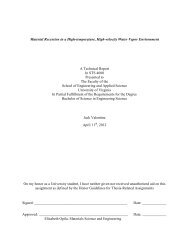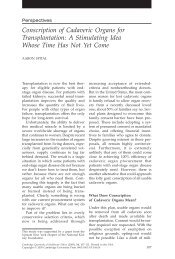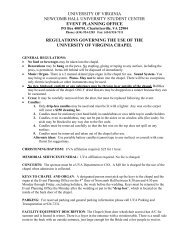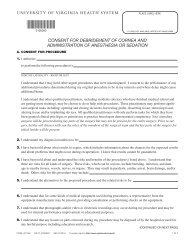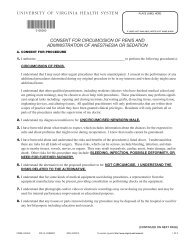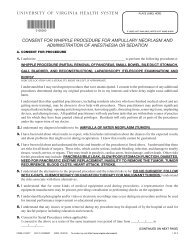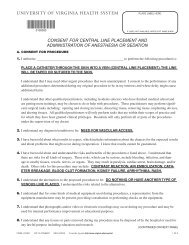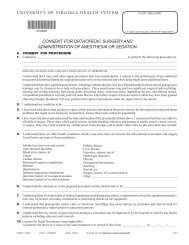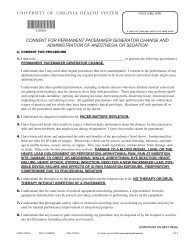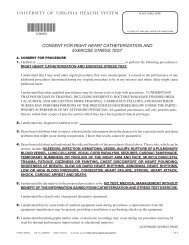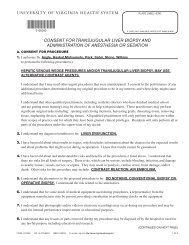Fine and Decorative Art - University of Virginia
Fine and Decorative Art - University of Virginia
Fine and Decorative Art - University of Virginia
Create successful ePaper yourself
Turn your PDF publications into a flip-book with our unique Google optimized e-Paper software.
<strong>Fine</strong> <strong>and</strong> <strong>Decorative</strong> <strong>Art</strong>Process Simplification<strong>University</strong> <strong>of</strong> <strong>Virginia</strong>
Table <strong>of</strong> Contents<strong>Fine</strong> <strong>and</strong> <strong>Decorative</strong> <strong>Art</strong> ................................................................................................................................ 2Process for Accepting, Cataloging, <strong>and</strong> Disposing <strong>of</strong> <strong>Fine</strong> <strong>and</strong> <strong>Decorative</strong> <strong>Art</strong> ............................................. 5Sample Process Simplification Methodology ................................................................................................ 6Acceptance <strong>and</strong> Maintenance <strong>of</strong> <strong>Fine</strong> <strong>and</strong> <strong>Decorative</strong> <strong>Art</strong> ........................................................................... 7Audit Report ................................................................................................................................................ 16Process Simplification 2
<strong>Fine</strong> <strong>and</strong> <strong>Decorative</strong> <strong>Art</strong>Definition<strong>Fine</strong> <strong>and</strong> decorative art includes the following types <strong>of</strong> items that could have considerablemonetary or historical value, or are <strong>of</strong> special significance to the <strong>University</strong>. Items such asposters would not generally be included unless it is rare, <strong>and</strong> therefore valuable. In general, finearts objects possess a quality that makes them worth more than their utility value.Examples <strong>of</strong> two-dimensional works include, but are not limited to, paintings, photographs,prints, <strong>and</strong> maps. Examples <strong>of</strong> three-dimensional works include, but are not limited to,sculpture, rugs <strong>and</strong> carpets, ceramics, china, silver <strong>and</strong> silverplate, metalware, lamps,c<strong>and</strong>elabra, glassware, textiles, object d'art (miscellaneous items), antiques <strong>and</strong> furniture.For additional information, please read “Acceptance <strong>and</strong> Maintenance <strong>of</strong> Works <strong>of</strong> <strong>Fine</strong> <strong>and</strong><strong>Decorative</strong> <strong>Art</strong>” available online: http://www.virginia.edu/polproc/pol/xe2.html#2.1.ActivityProcess Simplification is acting on the fine <strong>and</strong> decorative art recommendations put forth bythe Audit Department. <strong>Fine</strong> <strong>and</strong> decorative art includes non-museum pieces that are not theproperty <strong>of</strong> the <strong>University</strong> <strong>Art</strong> Museum, Alderman Special Collections, or the Kluge-RuheAboriginal <strong>Art</strong> Collection.These non-museum pieces are housed in academic departments <strong>and</strong> administrative <strong>of</strong>fices onGrounds. Some units (e.g., the Office <strong>of</strong> the Architect) have cataloged their collections, but nocomprehensive inventory <strong>of</strong> these non-museum pieces exists. The <strong>University</strong> has a well-writtenpolicy for fine <strong>and</strong> decorative art, but it is not been implemented consistently across Grounds.Process Simplification is meeting with experts on Grounds, gathering relevant information, <strong>and</strong>preparing to assemble a work group made up <strong>of</strong> primary stakeholders. Using processsimplification methods, the work group will:1) Determine process ownership2) Examine the fine <strong>and</strong> decorative art policy3) Recommend policy improvements4) Review <strong>and</strong> redesign current process as needed5) Develop compliance guidelinesIf a common inventory system is required, the work group will make recommendationsregarding its development, operation, <strong>and</strong> implementation.Problem StatementThe Audit Department, in its report entitled, Audit Observations in Planning for <strong>Fine</strong> <strong>and</strong><strong>Decorative</strong> <strong>Art</strong>s Audit, determined that:Process Simplification 3
No one unit was designated the responsible for fine <strong>and</strong> decorative art on Grounds.A comprehensive inventory <strong>of</strong>…fine <strong>and</strong> decorative art…does not exist.The <strong>University</strong> has a fine <strong>and</strong> decorative art policy, but it is not being followed….Thepolicy would need to be modified after the <strong>University</strong> determines who is responsible forthe inventory databaseThe <strong>University</strong> does queries departments through the annual ICQ about fine <strong>and</strong>decorative art, but the questions could be improved to provide more value.[These shortcomings pose numerous risks.] Unidentified fine <strong>and</strong> decorative art…could bestolen, lost/misplaced, or mish<strong>and</strong>led. This could result in loss <strong>of</strong> assets, bad publicity, <strong>and</strong>potentially unhappy donors. In addition, the items could be improperly managed.Process Simplification 4
Current Process for Accepting, Cataloging, <strong>and</strong> Disposing <strong>of</strong> <strong>Fine</strong> <strong>and</strong> <strong>Decorative</strong> <strong>Art</strong>Process Simplification 5
Sample Process Simplification MethodologyDiscover Redesign Realize Review pertinent documents (e.g.,audit, consultant report, <strong>University</strong>policies) Interview <strong>University</strong> experts <strong>and</strong>primary stakeholders Convene primary stakeholders Map process (fine & decorative artpolicy) Assemble work group Determine ownership Develop high-level charter (i.e., projectscope <strong>and</strong> approach) Establish area(s) <strong>of</strong> focus Develop recommendations Obtain commitment to redesignAnalyze policy <strong>and</strong> inventory strategiesRedesign processDetermine needs for cataloging,tracking, <strong>and</strong> reporting inventoryRecommend improvements forcataloging, tracking, <strong>and</strong> reportinginventoryRevise policy if neededQuantify costs <strong>and</strong> benefitsObtain commitment to realizeAppoint implementation team(s)Design system to catalog, track, <strong>and</strong>report inventoryDevelop training materialsTrain affected personnelImplement policy, process <strong>and</strong>, ifneeded, launch inventory systemProcess Simplification 6
Acceptance <strong>and</strong> Maintenance <strong>of</strong> <strong>Fine</strong> <strong>and</strong> <strong>Decorative</strong> <strong>Art</strong>Process Simplification 7
Process Simplification 8
Process Simplification 9
Process Simplification 10
Process Simplification 11
Process Simplification 12
Process Simplification 13
Process Simplification 14
Process Simplification 15
Audit ReportProcess Simplification 16
Process Simplification 17



